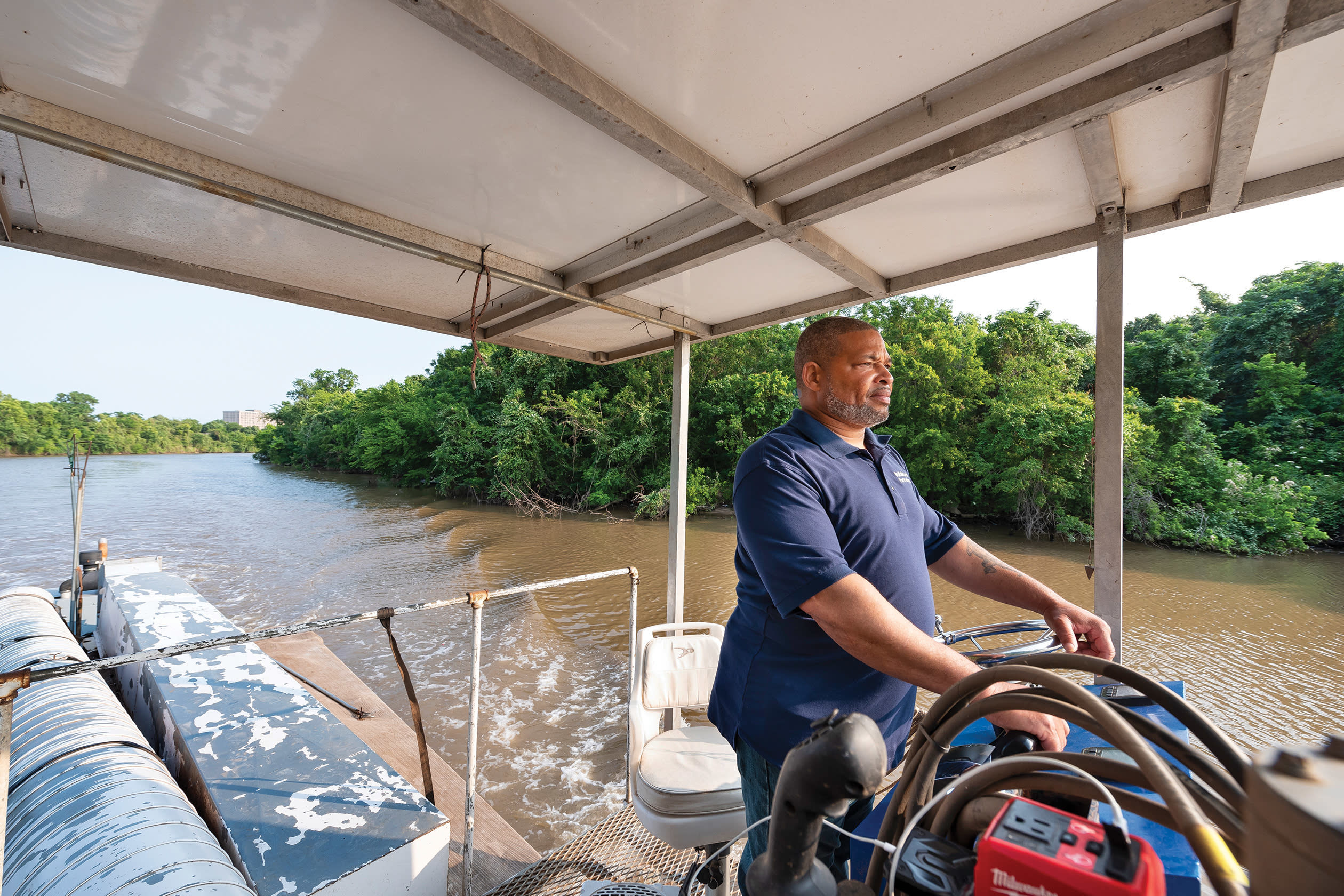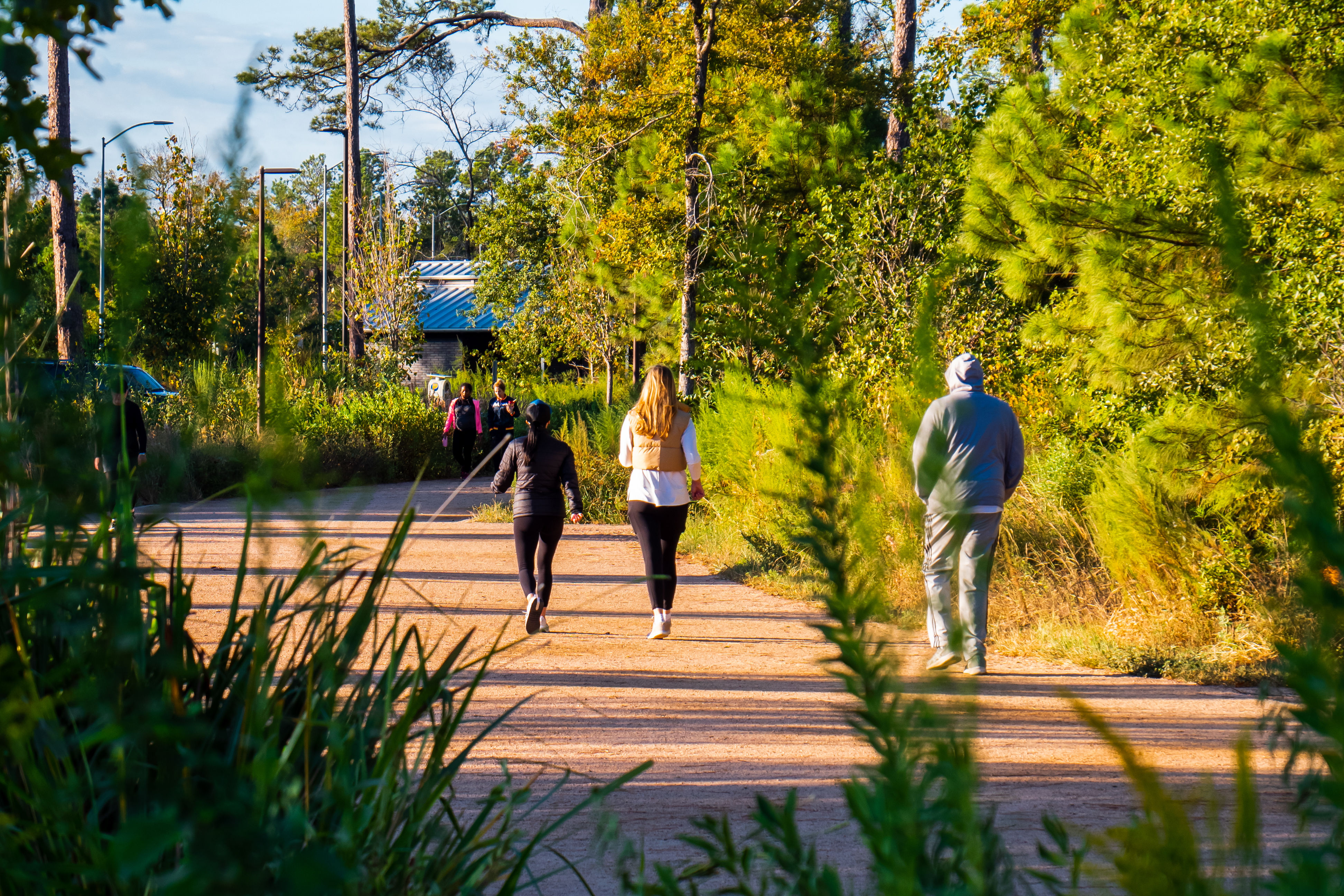Shining a Light on Armand Bayou Nature Center on 50th Anniversary

Image: NICKI EVANS
Birds chirping, foliage rustling with the wind, and a beautiful view of bayou water. It’s what Houston would’ve looked life if humans had never settled here, and it’s exactly what the Armand Bayou Nature Center is working to preserve. Tucked away in Pasadena, this hidden gem protects 2,500 acres of natural wetlands forest, prairie, and marsh habitats, and if you visit, you’ll forget you’re only about 30 minutes away from the bustling city life of downtown Houston.
The center, which celebrates 50 years in 2024, is one of the largest urban wilderness preserves in the United States—yes, the words “urban” and “wilderness” together might seem silly, but fitting as it’s sandwiched between Space Center Houston, University of Houston–Clear Lake, power plants in Baytown, and residential neighborhoods. Despite the surrounding urbanism, the center’s wilderness is home to more than 370 species of birds, mammals, reptiles, and amphibians. You can even spot a bison if you’re lucky.

Image: NICKI EVANS
“Urban sprawl is definitely an issue, we’re constantly being encroached upon, but this land, because it was set aside as a nature preserve back in 1974, will remain a nature preserve in perpetuity,” says Timothy Pylate, executive director of the Armand Bayou Nature Center.

Image: SHUTTERSTOCK.COM
We have the late local conservationist Armand Yramategui to thank for it—Pylate says to think of him as Houston’s own Steve Irwin. In the 1960s, Yramategui was often featured on the Howdy Doody show, where he spoke about the importance of saving the environment. In fact, he’s the reason every inch of the Texas coastline is open to the public today, after he petitioned the state legislature. Yramategui said the land that’s now named after him represents the confluence of three rapidly dying ecosystems that were once dominant across the Gulf Coast: the Texas coastal tall grasses, the riparian forest, and the bayou itself, alongside its accompanying marsh grasses.
One night in 1970, Yramategui was shot and killed after his car broke down on the side of the road. When others in the environmental community found out about his death, they decided to honor him with the creation of the center.

Image: NICKI EVANS
The mission
Pylate says the mission of the center is twofold: protect the habitats and educate the public as to why these habitats are so important. The center has public hiking trails, allows field trips, hosts Scout programs, and offers birding events, kayak tours, and pontoon cruises, all to raise awareness.
The Armand Bayou crew also does an astonishing amount of conservation work to maintain the habitat. Although the plants propagate themselves, the center did plant some of them in the native nursery before putting them out in the open. There are bayou cleanups and an annual “trash bash” event where people from all over get in their kayaks to collect trash. Pylate says plastics and other things often come from the nearby neighborhoods.

Image: NICKI EVANS
Another part of conservation is controlling any invasive species that makes its way down to the bayou. Take the water hyacinth, for example. It was brought over from South America as a landscape plant, often in backyard ponds, and has now naturalized in the southern US. Although it’s beautiful, a single patch can double in size every 10 days. This affects the churning and oxygenation of the water, which can lead to a mass death of fish.
The center also maintains the land by mimicking what bison herds used to do back when they roamed in large numbers. The animals would come through and decimate an area—the front of the herds ate the grassy plants, and the back beat down and trampled the woody plants. Today, the preserve mows the prairie to have the same effect as bison. Prescribed fires give room for new growth, when it’s safe to use them.

Image: NICKI EVANS
Meanwhile, to build on the educational part of the mission, the Armand Bayou Nature Center has partnerships with local institutions like Texas A&M University, San Jacinto College, Lee College, and the University of Houston–Clear Lake, and allows professors to hold lectures and classes on the land.
The Environmental Learning Center is home to various species such as snakes, a Texas brown tarantula, and an alligator snapping turtle, whose presence helps teach visitors about the wildlife in the Lone Star State. The center also has an auditorium for classes, lectures, and other business-related events, as well as three classrooms for kids’ programming. The learning center was built in 1978, but you might not be able to tell because it recently got a facelift, one of many things that have been underway as the nature center gets ready to celebrate its 50th anniversary.
Looking ahead
Over the past four years, the Armand Bayou Nature Center has been engaged in what it’s calling “The Renewal 2024 Campaign.” The goal is to renovate the center for visitors, as well as boost volunteering, donations, and memberships, while inspiring others to participate in environmental preservation. And while everyone loves a hidden gem, Pylate says the center has potential to gain even more attention from Houstonians and others who visit the city. The center welcomes about 40,000 visitors annually, a number he would like to see grow. This November, the center is set to unveil a 50-foot sculpture of an alligator on Bay Area Boulevard to attract more visitors.

Image: Shutterstock.com
“A lot of times, people pass by us and don’t really know what we are,” Pylate says. “We really want people to know what this place is, and we want people to say, Wow, we want to go visit and see what it’s all about.”
Looking to the future, Pylate says the hope is to purchase 1,160 acres that sit north of the center, land that is currently owned by Exxon, which the center’s staff learned five years ago was ready to sell. Now, the center is working closely with Exxon to purchase the property, but nothing is set in stone yet. Pylate says there is about 2,000 acres of green space left in the area, including the Exxon land, and his goal is to one day acquire and preserve it all.
“Once it’s gone, you can’t get it back,” Pylate says. “We want to transform it back into its former glory as a Texas coastal prairie. It’s our ecological heritage. It’s our legacy. This is who we are. This is Texas. This is something to be proud of right here on the Gulf Coast.”

Image: NICKI EVANS
IF YOU VISIT
- Location: 8500 Bay Area Blvd in Pasadena
- Hours: Wednesday through Saturday from 9am to 5pm, and Sundays from noon to 5pm (last entry is at 4pm)
- Cost: Free for kids 3 and under; $5 for ages 4–12, 60 and above, or if you’re a teacher, a first responder, a college student, or in active-duty military (ID required); $7 for everyone else. The ticket allows access to the walking trails, bison viewing platform, and a discovery loop.
- Activities: Join a guided kayak tour ($50) or if you’re scared of the alligators—we don’t blame you—hop on a sunset or sunrise pontoon cruise ($35 for nonmembers) or a mini cruise ($24 for nonmembers). There are also night hikes, bat hikes, safari bayou tours, and painting events, just to name a few options.
- Mark your calendar: Don’t forget to show up November 9 and 10 for the Armand Bayou Nature Center’s annual Fall Festival. This year, it will be a celebration of its 50th anniversary.




